
Exhibit reveals colors of Biscayne Bay
HOMESTEAD, Fla. — Gary Bremen leaned forward to get a good look at a small, faded green plant that looked like a miniature fan one would use to cool down on a hot, muggy day. He got as close to the glass case as possible.
After a few moments of observation, he finally turned away with a giddy smile on his face.
“This show was a personal labor of love for me,” he said.
| At right, Caulerpa mexicana by Marjorie Brown, one of the images on exhibit at the Visitor Center at Biscayne National Park. Below, Halimeda incrassata by Berverly Borland (Photos by Hannah Romig). | 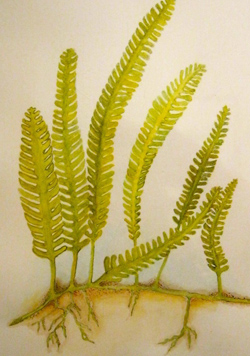 |
As an interpretive ranger at Biscayne National Park, one of Bremen’s responsibilities is to coordinate the community artists program that the park administers. Every three months, he sets up a new display of photos, paintings, diagrams or sculptures that are created by individuals or local organizations that find inspiration in the park.
Works are always displayed in the Dante Fascell Visitor Center, where guests are free to roam about and converse with a park ranger.
The Tropical Botanic Artists hold the current spot in the Visitor Center Gallery with an exhibit called “Macroalgae: Hidden Colors of the Sea.”
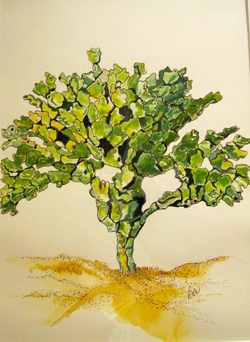 Watercolor depictions of blue, pink, green, yellow and orange algae decorate the walls with actual plant pressings taken from Biscayne Bay’s water scattering the collection. It is impossible to settle on a quick glance at these paintings.
Watercolor depictions of blue, pink, green, yellow and orange algae decorate the walls with actual plant pressings taken from Biscayne Bay’s water scattering the collection. It is impossible to settle on a quick glance at these paintings.
On the contrary, a closer look is necessary for an appreciation of the detail. Viewers are compelled to lean up to the matching wooden framed cases that protect the artwork to see every leaf’s vein, freckle and blotch.
“People are just blown away. I mean, this is a single cell,” said Bremen as he pointed to a fern-like piece of algae with feathered leaves. “People think of cells as microscopic, but these plans are enormous, beautiful. The press samples are great because people can see the relative size.”
Unlike other art exhibits that are prepared for display immediately after an artist makes a proposal, the Tropical Botanic Artists altered their artistic angle after some encouragement from Bremen.
Originally, they wanted to paint images of the land fauna found at Biscayne National Park.
“I was hesitant because we are mainly a marine park. We don’t need paintings of the plants on the land,” said Bremen.
Inspiration for the final product of “Macroalgae: Hidden Colors of the Sea” came with a Biscayne Bioblitz event where more than 2,000 people spent 24 hours counting up all the plants and animals species in the park.
In the hunt, a group of about 20 students from Florida International University distinguished themselves by discovering about 45 species of macroalgae that had never been documented in a park listing of local species.
“They created samples of them, brought them in and pressed them out. It was just this really cool story and to see people totally jazzed on finding these crazy little plants. It got me very excited about it too. They are beautiful, really amazing little plants,” said Bremen.
The new findings became a muse for the Tropical Botanic Artists. Instead of focusing on mangroves or hibiscus plants, their new exhibit captures the look and feel of marine macroalgae.
| Penicillus capitatus by Carol Onstad (Photo by Hannah Romig). | 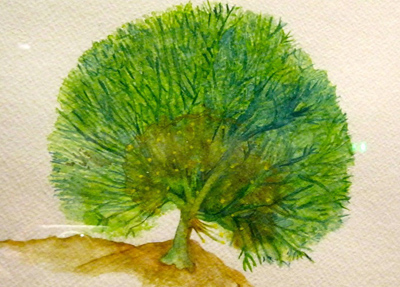 |
The 14 artists initially met in a botanical art class taught by Donna Torres at Fairchild Tropical Gardens. In recognizing their common love for nature, they established the collective artists group in 2006. Torres, who also teaches painting at Florida International University, served as an original co-director of the Tropical Botanic Artists.
“Our work shows a world that we really had not discovered yet,” said Torres. “It was a nice challenging project for us because we are used to painting land fauna, like flowers and leaves. We had the opportunity to get in there, into the water, and do something different.”
The process of putting the exhibit together involved a year of research with time spent out in the field, on park maintenance boats. The artists, who range in age from their mid-20s to late-80s, worked to recreate the minute details of the marine plants to expose a natural beauty that is largely unnoticed in everyday life.
“I love the combination of science and art in this collection because you get to see how beautiful nature is. You’re not making anything up. It’s just the natural way things look,” said Astrid Rybeck, a park ranger since 2000.
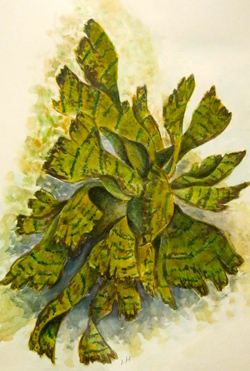 |
At left, Stypopodium zonale by Leo Hernandez. Next, the entrance sign to the Dante Fascell Visitor Center in Biscayne National Park (Photos by Hannah Romig). And last, 6: some of the artists who are part of Tropical Botanic Artists during a visit to the park (Photo courtesy of Donna Torres). |
In addition to art and science, the exhibit has historic appeal. Algae pressings date back to the 1860s, when Civil War prisoners used to collect the ocean plant life as a hobby.
Journals recovered from Fort Jefferson in Dry Tortugas National Park indicate that prisoners took time to arrange the leafy creatures on pages that they would send home to their families as Christmas gifts. These old pressings were publically displayed for the first time at the opening of Macroalgae: Hidden Colors of the Sea.
As far as maintaining a gallery in the park goes, Bremen believes that art and nature go hand in hand. The concept of using a camera or a paintbrush to depict the beauty of a natural space is not novel. Instead, the pairing of the two is a reason why national parks were first established.
“When people were looking to establish Yellowstone as a national park, they knew it was an indescribably place but they also knew other people didn’t really get it. So, what did they do? They sent out a painter and a photographer,” said Bremen. “They came back with these amazing black and white photos and these amazing paintings and people in the east couldn’t believe what they were seeing.”
“We are just continuing that process here to give people, especially in a marine park where a lot of people aren’t going to be able to go out on a rainy day like this, to give them a perspective that’s probably different from anything they were thinking about. You love to hear that you have literally changed someone’s outlook on the world,” he added.
Seeing something in a new way, but not necessarily for the first time, is an experience that Patricia Brody and Rob Scott plan for when they travel. Their vacations are always centered on national park sites.
A rainy Florida day did not stop them from driving out to Biscayne because they knew there would be something to unique to the environment.
“I learned quite a bit and we just came on our own. Every park is different and there are such a wide variety of things to see. Parks preserve natural habitats – things that you don’t get to see every day. There’s so much knowledge to be acquired and a lot of history,” said Scott.
The “Macroalgae: Hidden Colors of the Sea” exhibit at Biscayne National Park adds a personal touch to plant study that gives a new dimension to nature enjoyment. It upholds the national park system’s goal of stewardship, ensuring that people can go to a park and enjoy it in their own way.
“Some come to the park for recreational reasons and others come to find peace. If you’re an artist you come here to be inspired. It’s part of a park visitor’s right and is what makes the park beautiful,” said Rybeck.
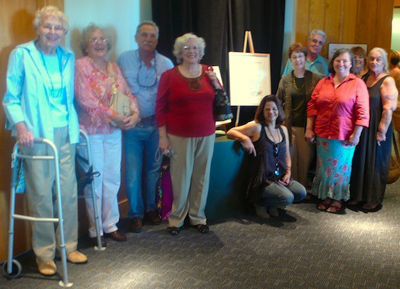 If You Go
If You Go
Dante Fascell Visitor Center
9700 SW 328 St., Homestead, Fla. 33033
Hours of operation: 9 a.m. – 5 p.m., daily
Current exhibit: “Macroalgae: Hidden Colors of the Sea”
Watercolor illustrations by Tropical Botanic Artists
Sept. 16 – Nov. 27, 2011
Upcoming exhibit:
“Bay Dreamings,” oil and pastels by John David Hawver
Dec. 2, 2011 – Feb. 26, 2012
Opening reception: 7 p.m. – 9 p.m., Dec. 2, 2011

Comments are Closed